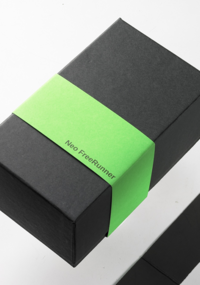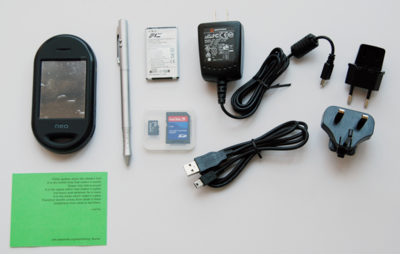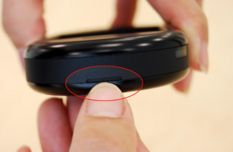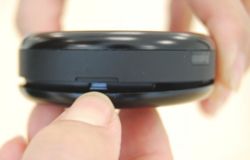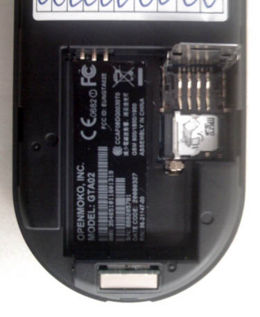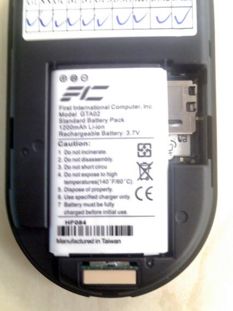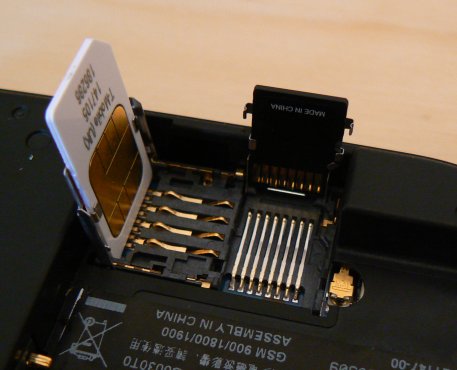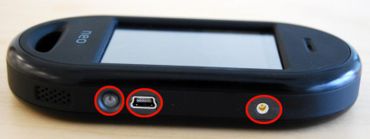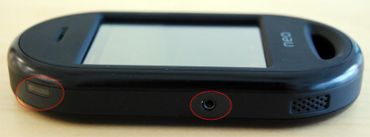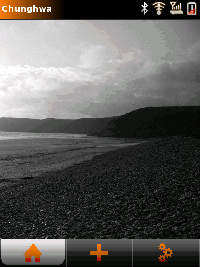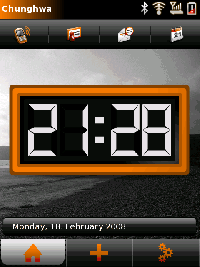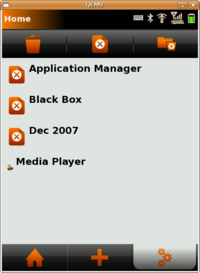Getting Started with your Neo FreeRunner
From Openmoko
| Languages: |
English • العربية • Български • Česky • Dansk • Deutsch • Esperanto • Eesti • Español • فارسی • Suomi • Français • עברית • Magyar • Italiano • 한국어 • Nederlands • Norsk (bokmål) • Polski • Português • Română • Русский • Svenska • Slovenčina • Українська • 中文(中国大陆) • 中文(台灣) • Euskara • Català |
Neo FreeRunner
|
Thank you for purchasing this Developer release of Neo FreeRunner. The Neo FreeRunner phone is the second hardware platform to take advantage of Openmoko. This guide will help you get to know your Neo FreeRunner and how to start using your Neo FreeRunner. Some Frequently Asked Questions for new owners are featured in the Getting Started FAQ. |
|---|
Contents |
Package Contents
-
 Neo FreeRunner
Neo FreeRunner
-
 Stylus
Stylus
-
 Battery
Battery
-
 Charger
Charger
-
 USB Cable (A -> Mini-B 5-pole)
USB Cable (A -> Mini-B 5-pole)
-
 microSD Card 512MB & SD adapter
microSD Card 512MB & SD adapter
Setting up the hardware, getting to know the Neo FreeRunner physically
Installing the Micro-SD card, the SIM card, and the Battery
- Remove the rear cover of the Neo FreeRunner by first holding the Neo FreeRunner on the side and then use your fingernail to prise off the rear cover at the slot on top of the device.
- Now you should be able to locate the combined SIM and Micro-SD card holder at the bottom of the battery compartment.
- Unlock the SIM card holder by sliding the metal clip down, towards the USB socket, with your fingernail. Use caution, as these parts are delicate and could be damaged by forcing them in the wrong direction.
- Lift up on the SIM card holder.
- The Micro-SD card holder is held in place by a latch on either side. It is easiest to open the Micro-SD card holder by releasing these latches one at a time rather than by lifting from the middle, as lifting from the middle tends to increase the latching pressure. A small screwdriver or knife can be used for this.
- Insert the Micro-SD card into the Micro-SD card holder. Note that on the inside of metal part of the holder there are little holding tabs for the card. Slide the card in these holders (on the metal part) before closing the card holder. Note that the electrical contacts should face down and towards the edge of the Neo Freerunner.
- Close the Micro-SD card holder, making sure that both latches of the holder are securely fastened.
- Insert the SIM card into the SIM card holder, taking care to slide inside the two metal tabs in the cover. Note that the electrical contacts should face down and that the cut corner should be closest to the external GPS Antenna Socket.
- Close the SIM card holder and lock it by sliding the metal clip towards the external GPS Antenna Socket on the FreeRunner.
- Insert the battery into the battery compartment, aligning the electrical contacts on the battery with the electrical contacts in the battery compartment. Insert the side with the electrical contacts first.
- Replace the rear cover on the FreeRunner.
[A short video] is also available. It was shot using the previous version of the Neo, but the installation procedures remains the same.
Charging the Neo FreeRunner
Before using the Neo FreeRunner for the first time, you should charge the battery completely. The battery can be charged using the provided charger (at 1000mA) or from a powered USB port capable of providing 500mA worth of current. Most computers will be able to charge the FreeRunner without any problems.
(Note: the provided charger includes three "national" plugs. The default is North America, with alternative U.K (3 square pins) and Euro (two round pins) adapters. To install the alternative power adapters, depress the latch in the cover (on the opposite side of the charger from the product information label) and slide the cover outward. Note that the two North American pins do not come out; the other adapters slide over them, and snap into place. The two-pin Euro adapter is removed in the same way as the cover. The three-pin U.K. adapter is removed by gently pressing the dummy ground pin (black) toward the end of the adapter with the cord and then sliding it off the adapter.)
Charging an empty battery at 100mA takes 12~15 hours, at 500mA takes 2,5~3,5 hours, and at 1000mA takes 1.5~2.5 hours. (90%~100%) [to be confirmed]
IMPORTANT: Make sure that the battery never discharges completely. This is an issue because the internal charging circuitry can not be turned on until the FreeRunner has booted, and booting through USB power alone does not work. Should the battery become completely discharged, your options are:
- Use external stand-alone charger (compatible with the Nokia BL-5C battery)
- Boot the FreeRunner with an alternative battery, or with a spare GTA01 or GTA02 battery, plug USB power, then switch to the empty battery.
- Boot the FreeRunner with a 4.5VDC external power source (steady hand and great care involved), plug USB power, then insert the empty battery.
Neo_FreeRunner_(GTA02)_Battery
Buttons and connectors
| Power
Tapping the power button exits the current application. Holding the power button brings up a menu allowing you to:
|
Aux
Tapping the Aux button hides or shows the currently running application. Holding the Aux button brings up a menu allowing you to:
|
Booting the Neo FreeRunner takes about 2 minutes overall, so patience is in order. The longest step comes after the Linux boot messages in very small fonts have scrolled by, at the graphical "openmoko" sunrise page.
The phone jack is a 2.5mm connector with four contacts: stereo + MIC. It is compatible with the headsets used by Motorola smartphones (A780,A1200, ...) and the V-360.
To plug regular (i.e. without microphone) headphones commonly used to listen to music, a compatible 2.5mm 4 rings jack to 3.5mm stereo jack adapter is needed. It has been reported that Nokia's 2.5mm -> 3.5mm adapters do not work, but that a 3.5mm Stereo Audio Adapter for Motorola MPx200/E398 works well. You will also want to switch from speaker output to headset, by restoring the appropriate alsa.state-file (usually the mediaplayer should do this for you) or via alsamixer (see below), to enable stereo output in there.
Unlocking the screen
When the screen is locked, you should see a Matrix-style green graphic with the Openmoko symbol in the middle of the bottom of the screen along with lock and unlock symbols. If you drag the Openmoko symbol to the unlock symbol at the top then the screen will become unlocked.
Note: this section describes the interface used by the "2007.2" image, which is the current default image for Openmoko. For some helpful tips on the "2008.8" image see this Om_2008.8_Guide
Today Page
Openmoko starts by displaying the "Today" page, which is your home page. Icons in the top row indicate the status of the phone. The bottom row consists of three tabs. The tab with a home on the left lead to the "Today" page you're viewing now. The central tab lead to the "Launch Task" page, which is the main menu used to start applications. The tab with gears on the right lead to the "Running Tasks" page, which is used to deal with currently open windows and applications.
See Today/2007.2 for more information about the Today page and customization.
Launch Task Page
| Stub: This is a stub. You can help OpenMokoWiki by expanding it. |
Current categories are PIM Suite, Applications, Games, Utilities, and All.
Running Tasks Page
| Stub: This is a stub. You can help OpenMokoWiki by expanding it. |
Exiting from and switching to an Application
Any time an application is running, you can simply click the device's power button and the application will exit, returning you to the Today page.
Alternatively, you can cycle through active applications using the AUX button
Clicking the top-left of the screen displays the drop down task menu. This menu lists all active applications and allows to switch directly to any one. Note: If the task menu is not shown, click and hold the Aux button to bring up the Aux menu, and select "Toggle Fullscreen".
Using the terminal
To start a console from "Today" page, click the middle tab at the bottom of the screen to display the "Launch applications" page, then select Terminal in the "Applications" submenu. The multitaps keyboard slides up (and down) from the bottom of the screen automatically when you touch the screen.
Setting date and time
From the terminal, type the following, but replace MM with the month (01-12); DD with the day (01-31); hhmm with the time (0000-2359); YYYY with the year (optional); and .ss with the seconds (optional).
date -s MMDDhhmmYYYY.ss
To make the change persist between reboots, sync the hardware clock with the updated system time.
hwclock --systohc
See Setting Date and Time for more discussion, including synchronizing with an NTP server.
Adjusting the Volume
As of this writing, there is no way to adjust the volume from the screen.
For now, run the terminal application or log in via usb, and run the Neo alsamixer application (to see all the options, including Mic2, you will need to run alsamixer -V all). The mixer is simpler than it looks. Just use the left and right arrow keys to select "headphone" or "PCM" and use the up and down arrow keys to adjust the volume. You can also adjust your microphone volume with the "mic2" adjustment. Press ESC when finished. Then exit the terminal application or log out of the USB login.
You may need to update configuration files in /usr/share/openmoko/scenarios/ to make the microphone setting permanent. Use
alsactl -f path-to-statefile store
to do this.
The default files are as follows (in /usr/share/openmoko/scenarios/):
- gsmhandset.state
- gsmheadset.state
- gsmspeakerout.state
- headset.state
- stereoout.state
These correspond to the various Sound Profiles accessible in the Debug Tool under Applications.
To manually restore one of the state files,
alsactl -f path-to-statefile restore
One way to increase the volume of the microphone is to do the following:
- ssh into your Freerunner
- vi /usr/share/openmoko/scenarios/gsmhandset.state
- search for "Mic2"
- change to "value 3"
If people report not being able to hear you when you call, then setting the Mic2 value to 2 or 3 should fix that.
Question: I am using headphones but only the right speaker work the left don't work how can I fix this ?
R: This should be set correctly by restoring gsmheadset.state. Pull and replug the headset jack to make sure the correct state-file is restored. To manually control the switch between Speaker and headset: Start alsamixer, scroll along to the right until you find "Amp Spk" and mute it (m), the sound will then come out from both channels of the headphones and not out of the speaker.
Accessing the microSD card
Mounted at /media/card by default.
If you have multiple partitions on the card, the first (/dev/mmcblk0p1) will be mounted at /media/card, the second at /media/mmcblk0p2, the third at /media/mmcblk0p3 etc. To setup the package management to write on the microSD card when installing new software follow the package management guide.
Set up USB-based networking, SSH and update
Openmoko allows TCP/IP-over-USB networking for your phone. The main advantages of this are
- You don't need to set-up GPRS or WLAN network connection for the phone software to reach the Internet
- You can SSH from your computer into the phone shell and comfortably do low-level tasks using your computer's terminal software and real keyboard instead of the tiny screen and touchscreen keyboard
Naturally, the phone must be connected to your computer with USB cable.
Connect with the Neo FreeRunner
This is discussed in the USB Networking section.
Update with the package manager
In order to keep the FreeRunner up-to-date with the latest features and bug-fixes, it is advisable update the software at regular intervals.
There are two main methods of doing this:
- upgrading with the package manager opkg
- or manually flashing the device (see Flashing the Neo FreeRunner).
There are three layers to the software on the FreeRunner:
- uBoot: Think of u-boot as a combination of the BIOS and Grub on a PC.
- Kernel: The Linux kernel
- Root Filesystem: The rest of the system
Note that uboot, the kernel and the root filesystem may all be flashed to update them. For uboot, this is the only possibility (see Flashing_the_Neo_FreeRunner#Flashing_the_boot_loader). The advantage of flashing the kernel manually rather than using opkg seems to be speed. The disadvantage of flashing the root file system is that it wipes out all local modifications, including /home. If /home is moved to the SD disk, this is no longer a problem.
Warning: UPGRADING TO DAILY KERNELS FROM THE DEVELOPMENT BRANCH MAY BREAK THINGS. That said, assuming that your FreeRunner can access the internet (see above), the kernel and other packages can be updated with
# opkg update # opkg -test upgrade # opkg upgrade
The first updates the repository information, telling opkg what packages are available. The second allows you to see what the package manager wants to do. The third upgrades all packages for which a newer version is available. At the moment, some signature files are missing (404 errors), which opkg complains about, but this is cosmetic. The repositories will still update with the missing signature files.
Note that running opkg upgrade on a factory-fresh phone will upgrade dropbear (the ssh software) and various xserver packages, and neither upgrades elegantly while in use. Xserver must be updated over ssh to complete succesfully. Dropbear can be updated over ssh with the proper command:
# nohup opkg upgrade dropbear &
Or upgrade it directly in the FreeRunner terminal.
# opkg upgrade dropbear
When updating over ssh, the session will be interrupted, but the command should complete successfully(check nohup.out on your device to verify), and you should be able to reconnect within a few seconds.
Another (better) option is to start a screen session before the upgrade with:
# screen
After loosing the ssh connection and login in again via ssh reconnect to the running screen session with:
# screen -x
Then connect to the FreeRunner via ssh and type:
# opkg upgrade
Recent changes to the usb ethernet support require that you install these two modules, before you reboot, after updating.
# opkg install kernel-module-g-ether kernel-module-cdc-ether
And run this command :
# depmod
| NOTE: http://lists.openmoko.org/pipermail/support/2008-August/thread.html#900 |
Alternatively you can upgrade the xserver packages via ssh and then upgrade the rest from the FreeRunner's terminal.
If you do your first upgrade in two installments like this, it will go more smoothly.
It will be possible in the future to update uboot with opkg, but this has not yet been implemented.
Installing multimedia, web browsing and other applications
There are many applications you can install - check out the Repositories for a list of packages, an example of how to add a repository using scaredy cat as an example can also be found here. A list of pre-installed and available packages with descriptions can be found here - Available Packages.
The calendar can be installed with
opkg install openmoko-dates2
For a Media Player:
opkg install openmoko-mediaplayer2 wget http://abraxa.dyndns.org:81/random/openmoko-mediaplayer-theme.tar.bz2 tar xjf openmoko-mediaplayer-theme.tar.bz2 -C /usr/share/themes/Moko/gtk-2.0 rm openmoko-mediaplayer-theme.tar.bz2
If you want a basic image viewer, have a look at the one from the gpe suite:
opkg install gpe-icons opkg install gpe-gallery
To obtain the standard web browser, use:
opkg install openmoko-browser2
An alternative browser, minimo, offers many more features. First download and unpack it on your GNU/Linux host:
wget http://www.ginguppin.de/files/minimo.tar.bz2 tar jvxf minimo.tar.bz2
Copy it over to the FreeRunner:
scp minimo_* root@192.168.0.202:/tmp
Then on the FreeRunner:
opkg install /tmp/minimo_0.02\+cvs20070626-r0_armv4t.ipk
You'll probably also want to change the keyboard including the keyboard toggle applet
Importing contacts
If you can export your contacts to VCard format, either multiple files or single file containing all of them, you may use the script on Import Vcf Contacts page to bring them to Neo.
The next steps
Congratulations for setting up your Neo FreeRunner. There are many more ressources to help free your phone:
Customize the interface
home screen clock, keyboard
The stock Openmoko2007.2 image flashed onto the Neo FreeRunner is really just the bare bones. For example, you don't have the clock and the quick-launch icons showing. Here's how you can change that:
# dbus-launch gconftool-2 -t boolean -s /desktop/poky/interface/reduced false # /etc/init.d/xserver-nodm restart
If you rather have a regular clock instead of the digital one, do this instead:
# dbus-launch gconftool-2 -t boolean -s /desktop/poky/interface/reduced false # dbus-launch gconftool-2 -t boolean -s /desktop/poky/interface/digital_clock false # /etc/init.d/xserver-nodm restart
REMOVE CLICK SOUND VIA /etc/pulse/session
More information about today screen customization at Today/2007.2.
Also, if you prefer having a full keyboard, using matchbox's qwerty keybord, see these instructions. Then you may also see these, which describe a way to add an applet allowing the showing/hiding of that keyboard.
Use the GPS
Simple guide to get going with GPS:
# opkg install gpsd # echo "GPS_DEV=\"/dev/ttySAC1\"" > /etc/default/gpsd
and restart gpsd, the gps daemon, with
# /etc/init.d/gpsd restart
To test GPS, you can use agpsui:
# opkg install openmoko-agpsui
For a nice map, try tangoGPS:
# opkg install tangogps
or download it from [1].
There were critical GPS Problems earlier that are largely fixed in newest kernels, see the instructions above to install the updates. More information is on the GPS page.
Play with WLAN, GPRS and Bluetooth
There are plenty of development opportunities to integrate these functions in the Openmoko software.
WLAN: See Wireless Networking
GPRS: See Manually using GPRS
Bluetooth: See Manually using Bluetooth
Testing a new distribution
Om 2008.8 is the successor to Om 2007.2 (and had ASU as a codename). It was launched on August 08, 2008. You may wish to test it or (if you feel adventurous) install it in place of the stock 2007.2 distribution you've just got to know.
Welcome to the community
The release of the Freerunner in the summer 2008 has led the community into a new period of rapid growth. The resources available are summarized on the Openmoko:Community_Portal. These are always exciting and interesting times to live in when the balance between Chaos and Order tilts towards change.
As an entry point, the [openmoko community mailing list] is perhaps the most active. As of July 2008, its volume amounts to dozens of messages per day. Openmoko people are there too. You may ask for help on the [support mailing list].
Or if you use IRC, there is always a good group in the channel #openmoko on FreeNode.
The links on the top-right of this page lead to the sister sites in the Openmoko community:
- Home and Wiki lead to the same Main Page on the wiki. It needs cleaning, we know...
- Doc leads to the bug Tracking system.
- Planet goes to the collection of Openmoko-relatd blogs.
- Projects is the GForge, free hosting for application developers.
- Lists is the listing of all the public mailing lists on lists.openmoko.org.
Annotated references
- The Quickstart guide. Largely used as a basis for this page.
- Neo FreeRunner. The top-level view of the specifications.
- Neo FreeRunner GTA02 Hardware. The detailed specifications.
- GTA02 Openness. Ultimate chip-level specifications, data sheets and hardware documentation.
- Distributions. Strengths and weaknesses of the various distributions available for the Neo.
- Getting Started FAQ. Answers.
- GTA02_FAQ. More answers
To search this wiki with Google, use the following search term:
<search term> site:http://wiki.openmoko.org/wiki/

